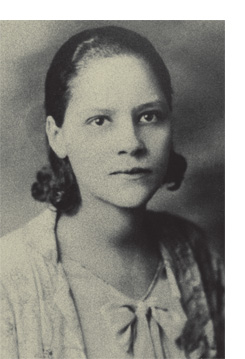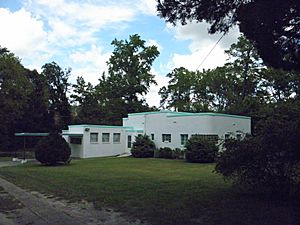Amaza Lee Meredith facts for kids
Quick facts for kids
Amaza Lee Meredith
|
|
|---|---|
 |
|
| Born | August 14, 1895 Lynchburg, Virginia, U.S.
|
| Died | 1984 (aged 90) |
| Resting place | Eastview Cemetery, Petersburg, Virginia, U.S. |
| Education | Virginia State University, Columbia University |
| Partner(s) | Edna Meade Colson |
Amaza Lee Meredith (born August 14, 1895 – died 1984) was an American architect, teacher, and artist. She faced challenges becoming an architect because she was an African-American woman. So, she mainly worked as an art teacher at Virginia State University. She even started the art department there!
Amaza Lee Meredith is famous for her home, Azurest South. She lived there with her partner, Dr. Edna Meade Colson. She also helped create the Azurest Syndicate Inc. This group developed a special vacation spot in Sag Harbor, New York, for middle-class Black Americans. Amaza was a rare example of an independent Black woman during the time of Jim Crow Segregation Laws.
Contents
Early Life and Family
Amaza was born in Lynchburg, Virginia. Her father, Samuel Peter Meredith, was a carpenter. Her mother, Emma Pink Kenney, was a seamstress. Amaza had two sisters and one brother. She stayed close with her older sister, Maude, throughout her life.
Amaza's parents faced challenges because her father was white and her mother was Black. They could not legally marry in Virginia at the time. However, Samuel cared for his family. He built them a house and supported them financially. Later, her parents traveled to Washington, D.C., to get married. They then moved in together.
Both of Amaza's parents greatly influenced her. Her father taught her how to draw blueprints and build models. This made her want to become an architect. Her mother believed that education was important to fight against unfair ideas about Black people. Amaza's mother was well-educated and active in her community. She encouraged her children to go to college.
At college, Amaza met Dr. Edna Meade Colson. They wrote letters to each other during Amaza's studies. Later, they moved into their shared home, "Azurest South". Their relationship was very committed and loving. They lived together until Amaza died in 1984. They are buried next to each other in Petersburg, Virginia. Amaza Lee Meredith lived a modern and independent life, even with the social challenges she faced.
Education
Amaza Lee Meredith started her schooling in Lynchburg, Virginia. She graduated at the top of her class from Jackson High School in 1912. She then went to Virginia Normal and Industrial Institute (now Virginia State University) to become a teacher. In her first year, she met Dr. Edna Meade Colson. Dr. Colson helped Amaza with her studies and suggested helpful books.
Amaza earned her "Summer School Professional Certificate" for teachers. She began teaching elementary school. In 1922, she returned to Petersburg to get her teaching degree. She was the best student in her class at Virginia Normal and Industrial Institute.
In 1926, Amaza moved to New York City. She lived with her sister in North Harlem. She studied fine arts and art at Columbia University. She earned her bachelor's degree in 1930. She took classes in interior design and home decoration. She also visited museums, which helped her understand modern design. During this time, she also learned about the New Negro Movement. This movement encouraged Black people to challenge stereotypes. Amaza became part of the "talented tenth". This was a group of educated Black Americans who aimed to help bridge the gap between different groups. She returned to Columbia University in 1934 to get her master's degree.
Career
Career in Education
After getting her first teaching certificate, Amaza taught in a one-room schoolhouse in Botetourt County, Virginia. She found the conditions difficult for the Black community there. So, she helped create the Parents-Teachers-Association to improve the schools.
Later, she taught elementary school in Lynchburg. After graduating in 1922, she taught math at Dunbar High School for six years. After earning her bachelor's degree, she returned to Virginia. She was hired by Virginia Normal and Industrial Institute to teach art.
In 1935, after getting her master's degree, she started the art department at Virginia State University. She was the head of the department until she retired in 1958. Amaza taught art education that included graphic design, fine arts, and architecture. She also helped create two art scholarships. She was very active in the Alumni Association.
Career in Architecture
Amaza Meredith cared deeply about her family, friends, and helping Black culture grow. She received Virginia's first land grant for African American scholars. Even though she was not a registered architect, she was one of the few Black architects at that time. She was also one of the very few Black female architects in the country.
Many of Amaza's early architectural works are no longer known. However, Virginia State University still honors her achievements. She designed houses in Virginia, Texas, and New York. Her most famous designs include two homes in Azurest North.
Amaza designed many homes for her family and friends. Her first building was Azurest South, finished in 1939. Amaza designed it herself in the International Style. This style uses clean lines and simple shapes. She and her partner, Colson, lived there for the rest of their lives.
Azurest South is a rare example of the International Style in Virginia. It shows Amaza's interest in new and exciting designs. She also used Azurest South as her art studio. She took many photos to document her life and work there. These records have helped people study race, identity, and design during the Jim Crow Era.
Amaza also used her artistic skills to choose colors and draw plans for several buildings on campus. For example, she worked on plans for an Alumni House starting in 1949. When her ideas were not chosen, she decided to give half of Azurest South to the Alumni Association after her death. Today, it is used as the Alumni House. Amaza also advised on interior decoration for the local Better Homes Committee.
In 1947, Amaza and her older sister Maude began developing a vacation community in Sag Harbor. It was called Azurest North. This community was for middle-class African Americans. Amaza, her sister, and other developers formed the Azurest Syndicate. They worked to create this leisure community. People bought lots and built cottages there. Amaza designed at least two of these cottages. Terry Cottage, built in 1949 for her sister Maude, looked similar to Azurest South. Edendot, for her friends Ed and Dot Spaulding, was a Prairie Style building.
After she retired, Amaza became the official secretary of the Azurest Syndicate Inc. In 1986, Azurest South became the home of the Virginia State University National Alumni Association. The building was added to the National Register of Historic Places in 1993. In 2008, a special highway marker was approved to honor Amaza Lee Meredith.
Other Achievements
Amaza Meredith was also an inventor. In 1955, she received a patent for an accessory that could be attached to a golf bag. She also created the "Kant Drop," a top that could be used on any recyclable container. She continued to design buildings and paint throughout the 1960s. Some of her artwork was shown in the Virginia Museum of Fine Arts and galleries in New York and North Carolina. Some of her art is still displayed in the Gillfield Baptist Church or in people's homes. In the 1970s, Amaza designed logos for a possible name change for the National Association for the Advancement of Colored People (NAACP).
Buildings
- Amaza Lee Meredith, Edna Meade Colson “Azurest South”, 1939, Ettrick Virginia
- Richards, Dr. F.F. “Hillside”, 1946, Sag Harbor NY
- Virginia State University Alumni House, 1949, Ettrick Virginia – plan only
- Spaulding, Dorothy “Edendot”, 1951, Sag Harbor NY
- Terry, Maude “HIHIL”, Sag Harbor NY
- Johnson, Dr. James H, 1954, Ettrick, Virginia
- Preston, Ann C. “Anndot”, 1956, Prairie View
- Gillfield Baptist Church Education Building, 1964, Petersburg Virginia
- Parker, Evelyn L., 1975 - Plans only
- Reed, Ettrick – Plans only
See also
 In Spanish: Amaza Lee Meredith para niños
In Spanish: Amaza Lee Meredith para niños


